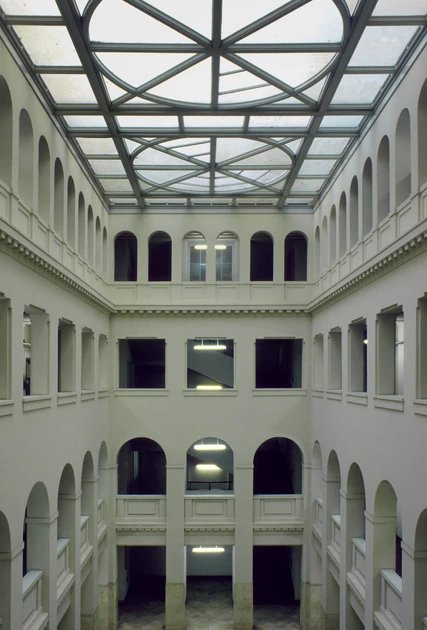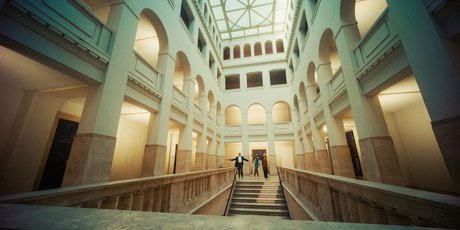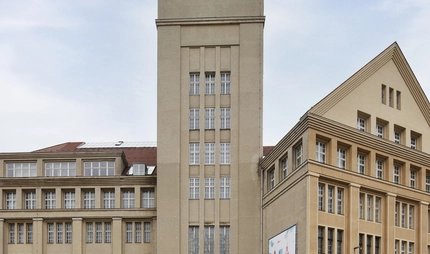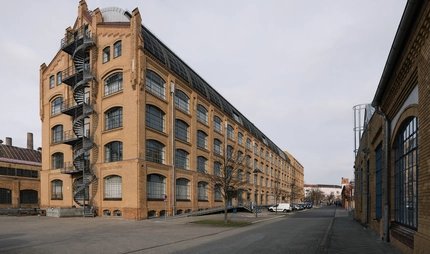
The NAG building
Democratisation through architecture
The NAG building by Peter Behrens is an expression of the new approach to industrial architecture at the start of the 20th century.
The building is currently closed.
Over the next few years, the entire site in Oberschöneweide will be transformed into a sustainable and liveable future neighbourhood with a mix of commercial, residential, educational and cultural facilities. At the same time, listed buildings are to be preserved and space created for new developments. New public squares and a continuous riverside promenade are also planned. The site will remain accessible throughout the entire transformation process. Experience first-hand how a former industrial site is being transformed into an innovative location with people at the centre.
Historic start-up centre
At the end of the 19th century, Oberschöneweide became a centre for industrial enterprises, particularly from the electrical sector. One of them, AEG, later became a global corporation. Its founder, the industrialist Emil Rathenau, was already convinced of the future importance of the automobile at the turn of the century and founded Neue Automobil-Gesellschaft AG in 1901.
When the First World War broke out, the company stopped manufacturing civilian commercial vehicles and started producing goods for the war effort such as troop transporters and aeroplanes. The production facility was patriotically renamed the Nationale Automobil-Gesellschaft in 1915.
A new building by Behrens
During the war, production continued to increase, so Emil Rathenau decided to build a new factory. The contract went to the architect Peter Behrens, who had been a member of the artistic advisory board of AEG since 1907 and built the AEG turbine hall in Moabit in 1909.
With the turbine hall, Behrens had already succeeded in laying the foundation for modern industrial architecture. Suddenly, types of building which had previously been designed on a purely functional basis became the focus of architecture. Before the turn of the century, civil engineers designed simple production halls, often giving them a pseudo-historical façade that disguised their working function.
Walter Gropius, who as a young architect worked for Behrens, said in 1911:
“As workplaces we must erect palaces which not only give the factory worker, that slave of modern industrial production, light, air and cleanliness, but also convey to them something of the nobility of the great communal idea that drives the whole undertaking.”
Peter Behrens knew how to build palaces for work, and proved it in Oberschöneweide too. Between 1915 and 1917, in the middle of the war, a building was erected that combined industrial production and modern architecture. Emil Rathenau didn’t live to see its completion, having died in 1915. The business was taken over by his son Walther Rathenau, who later became Germany’s Foreign Minister.
External appearance
For the NAG building, now also known as the Peter Behrens Building, the architect combined individual parts of the facility, such as halls and multi-storey factories, in a single monumental building with a 1,000-meter-long façade.
The administration and production were housed in a five-storey building arranged around the assembly hall like a horseshoe. In the middle was a 60-metre-high tower which supplied the plant with fresh water. The water tower is still one of the most striking architectural monuments in Oberschöneweide and gives the Peter Behrens Building an appearance reminiscent of a town hall. He integrated the industrial building into the cityscape and linked automotive production to public life in Oberschöneweide.
As with the AEG turbine hall in Moabit, Behrens used classic architectural elements for the façade design: the broad pillars between the windows looked like pilasters, flattened half-columns raised from the wall. The fifth floor was designed as a mezzanine, a stylistic device that dates back to the Renaissance. The clear forms and the structure provided by the water tower opened up the façade.

Inner values
Visitors entered through a large, arched gate into an atrium, from which a staircase led to the building’s impressive entrance hall. The geometrically divided ceiling let light into the rectangular hall, creating space and transparency.
Galleries ran along four floors around the hall. Each of them was structured by differently designed arcades, simple rectangular or arched recesses reminiscent of Renaissance palaces.
With this elegant entrance, Behrens gave the industrial building the nobility that Gropius demanded. The entrance hall was for everyone. It had a democratising effect – every employee, from the workers to the factory director, passed through it in the morning on the way to work. On one side, the doors led to the administrative offices, on the other to the production facilities. This meant that the space in many ways embodied the ideal of an industrial society characterised by participation.
After the war, the building was used for various purposes, including as a factory for electronic television components in the GDR. After reunification, Samsung took over the building and produced cathode-ray tubes for televisions. Since 2010, it has belonged to a real estate company that leases the premises to medium-sized companies.
Our tips for the NAG building
Close by the NAG building you’ll find another industrial heritage site that belonged to AEG: the Oberspree Cable Works was built at Wilhelminenhofstraße 76 between 1897 and 1914. It’s closely linked to the history of electrical engineering. You can dive into another part of German history at Wuhlheide, where you’ll find the FEZ leisure and recreation centre, whose main building opened in 1979 and was known in the GDR as the Ernst Thälmann Pioneer Palace.
Practical information from visitBerlin
You can get to the NAG building by taking the number 27, 60, 61 or 67 tram to Rathenaustraße/HTW. To explore the city by public transport, we recommend the Berlin Welcome Card.


